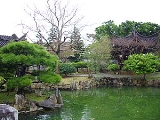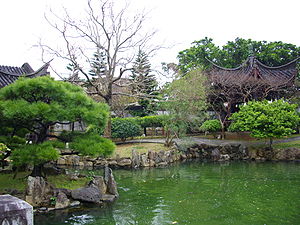
Fukushuen
Encyclopedia

Chinese garden
The Chinese garden, also known as a Chinese classical garden, is a style of landscape garden which has evolved for more than three thousand years, and which is inspired by Chinese literature, Chinese painting and Chinese philosophy...
in the Kume area of Naha, Okinawa.
The garden was constructed in 1992, in celebration of the 10th anniversary of the establishment of the sister city relationship
Town twinning
Twin towns and sister cities are two of many terms used to describe the cooperative agreements between towns, cities, and even counties in geographically and politically distinct areas to promote cultural and commercial ties.- Terminology :...
between Naha and Fuzhou in China. The Kume neighborhood where the garden is located, previously known as Kumemura
Kumemura
Kumemura , located on Okinawa, in the port city of Naha and near the royal capital of Shuri, was a community of scholars, bureaucrats, and diplomats, and a center of culture and learning during the time of the Ryūkyū Kingdom...
(Kume Village), was for centuries the center of Chinese culture and learning in the Ryūkyū Kingdom
Ryukyu Kingdom
The Ryūkyū Kingdom was an independent kingdom which ruled most of the Ryukyu Islands from the 15th century to the 19th century. The Kings of Ryūkyū unified Okinawa Island and extended the kingdom to the Amami Islands in modern-day Kagoshima Prefecture, and the Sakishima Islands near Taiwan...
, and a symbol of the significant role of Chinese cultural influence in Okinawan history and culture.
The garden was built nearly entirely with the use of wood and stone from Fuzhou, with the help of artisans from Fuzhou, and according to specifications representative of traditional gardens in Fuzhou. It thus contains many of the elements essential to the design of a traditional Chinese garden. It is walled, divided into individual sections, features much asymmetry, rocks including scholar's rocks
Chinese scholar's rocks
Chinese scholars' rocks or Gongshi , also known as scholar stones or viewing stones, are small shaped or naturally occurring rocks appreciated by Chinese scholars from the Song dynasty onwards, and quite frequently found in traditional Chinese gardens.The most highly regarded stones are lingbi...
, and water in the form of a single pond which extends into most sections of the garden. Several bridges in a variety of styles extend over the pond, which houses koi
Koi
or more specifically , are ornamental varieties of domesticated common carp that are kept for decorative purposes in outdoor koi ponds or water gardens....
and turtles, a symbol of longevity and wisdom in Chinese culture. The centerpiece of the garden perhaps is its waterfall, located on the west side of the pond, directly facing the east entrance. The rock pile it flows from contains an artificial cave, and can be entered, and climbed; stairs cut into the rock lead to a Chinese-style pavilion
Chinese pavilion
.Chinese Pavilions are covered structures without surrounding walls and are a traditional part of Chinese architecture. While often found within temples, pavilions are not exclusively religious structures...
, one of two high points in the garden allowing for a view of much of the garden, and the surrounding scenery.
The garden also has gates on the four cardinal directions, a number of six-sided pavilions, sculptures, bells, several inscriptions painted large on wood and stone, and in one building, a small exhibit of Chinese painting
Chinese painting
Chinese painting is one of the oldest continuous artistic traditions in the world. The earliest paintings were not representational but ornamental; they consisted of patterns or designs rather than pictures. Early pottery was painted with spirals, zigzags, dots, or animals...
s and of a model of the style of ship that would have journeyed to Fuzhou during the time of the Ryūkyū Kingdom to bring tribute
Tribute
A tribute is wealth, often in kind, that one party gives to another as a sign of respect or, as was often the case in historical contexts, of submission or allegiance. Various ancient states, which could be called suzerains, exacted tribute from areas they had conquered or threatened to conquer...
and to engage in trade. The Chinese and Japanese concept of "borrowed scenery" (借景, C:jie jing, J:shakkei) is also used, adding to the sense of the garden's size. One element indicative of Okinawa, however, is seen in the plants and trees chosen for the garden. Trees such as Murraya paniculata
Murraya paniculata
Murraya paniculata, commonly called orange jasmine, is a tropical, evergreen plant bearing small, white, scented flowers, which is grown as an ornamental tree or hedge. Murraya is closely related to Citrus.- Synonyms and Common & Local Names :...
, a relative of the orange and mikan
Mikan
The satsuma is a seedless and easy-peeling citrus mutant of Japanese origin introduced to the West.In Japan, it is known as mikan or formally unshu mikan . In China, it is known as Wenzhou migan . The Japanese name is a result of the local reading of the same characters used in the Chinese...
, called gekkitsu (月橘) in Japanese, and Acacia confusa
Acacia confusa
Acacia confusa is a perennial tree native to South-East Asia. Some common names for it are Acacia Petit Feuille, Small Philippine Acacia, Formosa Acacia and Formosan Koa. It grows to a height of 15m...
, called sōshiju (相思樹) in Japanese, both native to the Ryukyu Islands
Ryukyu Islands
The , also known as the , is a chain of islands in the western Pacific, on the eastern limit of the East China Sea and to the southwest of the island of Kyushu in Japan. From about 1829 until the mid 20th century, they were alternately called Luchu, Loochoo, or Lewchew, akin to the Mandarin...
, Taiwan
Taiwan
Taiwan , also known, especially in the past, as Formosa , is the largest island of the same-named island group of East Asia in the western Pacific Ocean and located off the southeastern coast of mainland China. The island forms over 99% of the current territory of the Republic of China following...
, and parts of Southeast Asia, were chosen for their aesthetic qualities, particularly for their flowers, which allow the garden's appearance and atmosphere to change with the seasons in a particular way appropriate for a traditional Chinese garden.
Access to the garden is open to the public; there is no admission fee, though it is only open certain hours of the day and is closed on some days of the week.

